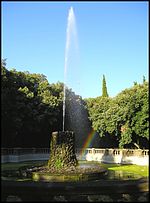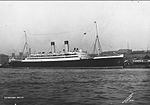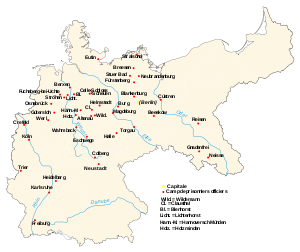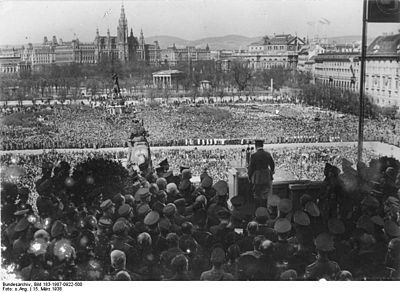- Conrad O'Brien-ffrench
-
Conrad Fulke Thomond O’Brien-ffrench, Marquis de Castelthomond 
Conrad O'Brien-ffrench c. 1919Nickname Eagle (Regimental nickname 1921)[1] Born November 19, 1893
London, England[2]Died October 23, 1986
Loveland, Colorado, United States[3]Allegiance  United Kingdom
United KingdomYears of service 1912, 3rd batt. Royal Irish Regiment;[4] 1914-1919, served in World War I; 1922, Capt. 16th The Queen's Lancers; 1919-1920, assist. mil. attache at Stockholm; 1920-1921, at Helsingfors; 1922, A.D.C. to Gov. of United Provinces, India[2] Rank Captain, 16/5 Lancers[2] Unit Royal Irish Regiment (Disbanded 1922. Not the current Regiment created 1992); 16th The Queen's Lancers[4] Battles/wars Mons, World War I[4] Awards The 1914 Star, Clasp & Emb., 8/13/1914 (Mons Star);[4] The 1914 British War Medal (Squeak), 1914-1918;[4] The Allied Victory Medal (Wilfred);[4] Knight of Honour and Devotion of the Order of St. John of Jerusalem[2] Other work SIS/MI6 Agent ST36 1919-1922. He rejoined in 1930 and became an operative (Agent Z3) for Claude Dansey's Z Organization until 1938.[1] Conrad Fulke Thomond O’Brien-ffrench (November 19, 1893[2] - October 23, 1986[3]), was a distinguished British Secret Intelligence Officer, Captain in the Tipperary Rangers of the Royal Irish Regiment and 16th The Queen's Lancers in World War I, and Mountie for the Royal Canadian Mounted Police.[4] He was also an accomplished artist, linguist, mountaineer, skier and author.[1]
Contents
Early life and education
Born in London, England, Conrad Fulke Thomond O’Brien-ffrench was the second son of Henry Albert De Vreque O'Brien-ffrench (Marquis de Castelthomond) and his wife Winifred Thursby, heiress and daughter of Major James Legh Thursby, of Ormerod House Lancashire.[5][6]
He and his older brother Rollo (Rollo Adrien Vladimir Thursby Marie Altieri O'Brien-ffrench) spent their early childhood in Italy at Villa Torlonia (Frascati) in the Albany Hills, east of Rome, and then at Piazza dell'Indipendenza in Florence, where they received private tutoring in English, French and Italian.[7] Returning to England, Conrad joined Rollo at the Wick, a preparatory school in the Hove district of Brighton. Following Rollo's graduation, Conrad completed his prep school at St. Aubyn's Preparatory School in Rottingdean, after which he attended Bradley Court Agricultural College in the Forest of Dean, where he developed his lifelong interest in horsemanship, fox hunting and other country pursuits, and became a junior member of the Ledbury Hunt. During these years his other siblings, Yvonne (Yvonne Castelthomond O'Brien-ffrench)[5] and Alexis (Alexis Evelyn Henry O'Brien-ffrench),[5][8] were born.
Royal Canadian Mounted Police
At age 16, Conrad's life took an abrupt turn when Rollo died in an accident playing football.[5][8] Conrad left school at this time to study farming in the Evesham Valley, and while there he met a Justice of the Peace from Buffalo Lake Ranch in Saskatchewan, who told him of life on the wild frontier and of the Royal Canadian Mounted Police.[1] In April 1910, at age 17, Conrad sailed on the Empress of Britain for Quebec and continued west to join the Royal North-West Mounted Police in Saskatchewan.[1][9]
After basic training Conrad was posted to Cypress Hills (Canada), a remote and untamed area. He was later posted to Willow Creek and then Battle Creek, but mid-1912 received word that his mother was dying from cancer.[1] He purchased his release and returned to Esher in Surrey to be by her side.[1] She died the following summer.[5][8]
During this time Conrad and friends took weekend trips to the Brooklands race track, where he was introduced to motor racing. Subsequently he purchased a 1909 Mercedes Simplex and developed a taste for fast cars.[7]
Military service
Battle of Mons
Following his mother's death, Conrad traveled to his ancestral homeland in Ireland and joined The Tipperary Militia, a special reserve unit of the Royal Irish Regiment.[2] In August 1914 he was promoted to Captain and engaged in the Battle of Mons with his regiment as part of the British Expeditionary Force.[9][10] On the first day of battle he was severely wounded, captured and taken prisoner.[4] He was held first at Torgau, a Bismarckian fortress, and then at Burg de Magdeburg POW camp.[11]
After numerous failed escape attempts, he was transferred to what was considered an escape-proof camp at Augustabad.[7] Here Conrad began an exchange of letters with his friend Cathleen Mann, and through the use of invisible ink, transmitted details of troop movements and other strategic information gathered from incoming prisoners.[12][13][14] One communication included information about a prototype German Bomber that he obtained from a captured British pilot.[1] Her job as secretary to Stewart Menzies of British counterintelligence, allowed a speedy relay of information through Menzies to Field Marshal Douglas Haig.[15][16] Attempts were made to extract Conrad and the pilot to London, but these failed and Conrad remained in Augustabad.[1]
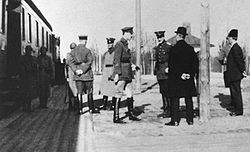 Conrad O'Brien-ffrench (profile view, centre) with Russian diplomat Leonid Krasin (in bowler hat) and twenty-five-member delegation, en route to London for talks with Prime Minister Lloyd George, 1920.[17][18]
Conrad O'Brien-ffrench (profile view, centre) with Russian diplomat Leonid Krasin (in bowler hat) and twenty-five-member delegation, en route to London for talks with Prime Minister Lloyd George, 1920.[17][18]
MI6
Following the war, Conrad was summoned to Whitehall in December 1918 to meet then Colonel Stewart Menzies, who recruited Conrad into MI6.[19] At the time, Menzies reported to Captain Mansfield Smith-Cumming, the first head of the British Secret Service, who was called "C", a designation that remains to the present day (not the "M" of popular fiction).[20] He was posted to the British Legation in Stockholm as Assistant Military Attaché under the command of Major Dymoke Scale.[9] While a POW, Conrad had learned fluent Russian, and was now tasked with gathering information from Russian refugees fleeing the aftermath of the 1917 revolution.[1]
In 1920, Conrad was assigned to escort Russian diplomat Leonid Krasin through countries hostile to the new Communist government to meet with Prime Minister Lloyd George in London for secret talks about the restoration of trade with the West.[17][18] (Dispatches from Lord Acton, British Minister Plenipotentiary to the newly independent Finland, confirmed arrangements for a special train to meet the delegation and under heavy guard they traveled to Turku, Finland, then Sweden to reunite with Krasin's family, en route for England.[21] This event, the first face-to-face meeting between Russian Communist leadership and the outside world, led to the Anglo-Soviet Trade Agreement of March 1921.[18][22]
Subsequently, the postwar depression and easing Soviet-British relations caused cutbacks to the Secret Service, and Conrad resigned from the service and returned to England.[7]
 The Prince of Wales, 1919, during his Royal Tour of India (December 1921 through April 1922) Conrad served as an Aide-de-camp to one of the British Governors on this tour.[9][23]
The Prince of Wales, 1919, during his Royal Tour of India (December 1921 through April 1922) Conrad served as an Aide-de-camp to one of the British Governors on this tour.[9][23]
India
Upon his return, Conrad was assigned as an Aide-de-camp to one of the British Governors for the upcoming Royal tour of India.[9][23] Edward VIII, then the Prince of Wales, arrived in India on December 21, 1921, and stayed until April 1922.[24][25] During this time the Indian National Congress of Mohandas Karamchand Gandhi and Jawaharlal Nehru was in full swing, and the Royal tour was dogged by passive demonstrations and riots.[26] The heavy handed response of the British to this resistance played a part in the end of the British Raj.[27]
In February 1922, Conrad witnessed a meeting requested by the Viceroy of India, Lord Reading (Rufus Isaacs, 1st Marquess of Reading), with the Prince to discuss the possible arrest of Mohandas K. Gandhi.[7] On February 1, 1922, Gandhi had written a letter to the Viceroy informing him of the Bardoli district's decision to commence mass civil disobedience and non-payment of taxes, unless the Viceroy declared a policy of non-interference with non-violent activities.[26][28][29]
On February 4, 1922, upon learning that the sub inspector of Chauri Chaura police station assaulted Congress volunteers at Mundera Bazar, an angry mob gathered at the station, demanding explanation from the guilty official.[30] While the crowd marched on, shouting anti-government slogans, police fired warning shots agitating the crowds further.[30] In response the crowd began throwing stones at the police, who were then ordered to open fire, killing three and wounding several others. The police retreated, some believe due to lack of ammunition while others attribute it to fear of the angry and courageous crowd. Chaos ensued and the heavily outnumbered police returned to the shelter of Thana (City Hall). The enraged crowd challenged the police to come out of their den, and on paying no heed, took revenge by setting the Thana on fire, killing 22 officers (including the station officer) who were trapped inside.[27][30][31]
Gandhi did not support the violent actions, and consequently suspended the Non-cooperation movement at its peak.[31] British officials hoped to suppress the civil disobedience by arresting Gandhi, and on March 10, 1922, Lord Reading ordered Gandhi's arrest.[30][32][33][34] The initial discussion that Conrad witnessed was now a reality, Gandhi had been arrested, tried and jailed, but the results were not as the British intended.[27] Conrad experienced firsthand the transformative influence of one man as he peacefully expressed true character, and soon the control of the British Raj gave way to India's leadership.[7]
Mountaineering
During Conrad's stay in India, he was introduced to mountaineering and the Himalayas.[7][35] One of his more dangerous climbs was near Srinagar in the Vale of Kashmir.[36] While climbing the Skoro La Pass, a mountain downpour created dangerous conditions, transforming the rocky cliff his party was ascending into an icy waterfall. A landslide, freezing conditions and dwindling light forced the team to rapidly forge an alternative route. Conrad led the team to safety, and ultimately to the summit.[37]
Conrad explored the Himalayas, Austrian Alps and other world ranges, meeting Sir Francis Younghusband, Frank Smythe, Sir John Hunt and Sir Edmund Hillary.[35] In The May Mountaineer, Conrad describes skiing adventures among the towering peaks and glaciers of the Austrian Alps.[38] When living in Banff, he often rock-climbed and ski'd in the Lake and Fairhome ranges.[35] Elected to the Alpine Club in 1933, Conrad became a lifelong member.[35] The following are some of Conrad's earlier climbs, documented upon his nomination to the Alpine Club in London, England.[39]
Expeditions
Year Mountain Range Expeditions Notes Images 1921 Himalayas, Pakistan From Srinagar to Burzil Pass then over Burgi La to Scoro La and onto Mango Gusor (20,625 ft. / 6288 m.)[40] Guide: H. Tantari 
1928 Switzerland Glacier of Arolla (Pennine Alps, canton of Valais, Switzerland) to Mont Collon (11,932 ft /3,637 m, Pennine Alps)[41] 
Dent de Perroc (12,057 ft /3,675 m, Wallis, Switzerland)[42] 
Aiguilles Rouges (Switzerland) 
Mt. Arolee (in winter) Guide: Camille Bonnisson 1930 Dolomites, Italy Latimer from Col. Canon Rosengarten. Gr. Cront & Pie. Gront. Langkofel (10,436 ft / 3,181 m, Dolomites, Italy)[43] 
Piz Boè (10,341 ft / 3,152 m, Dolomites, Sella group, Italy)[44] Guide: P. Dawetz 
Marmolada (10,964 ft / 3,342 m, Dolomites, Italy)[45] Corono di Putla Mt. Telegrafo (Cima Telegrafo, 7,238 ft / 2,206 m, Italy)[46] Pusanelle 1931 Haute-Savoie, France Aiguille de Tré-la-Tête (12,894 ft / 3,930 m), to Aiguille de Beranger Col de la Seigne (glacier, Mont Blanc) 
Col di Sanaorlis Cirque de Gavarnie (central Pyrénées) McCauigon ind the Ridge from Pique de Rongeat to Cime de Pomerol With Mrs. ffrench 1932 Islas Canarias, Lanzarote, Spain Monte Corona (1,985 ft / 605 m, Islas Canarias, Lanzarote, Spain)[47] Volcano on Islas Canarias 
Peaks from Col de Capronale towards Cap Binco Mountains Corsica, région of France Capo al Berdato (peak in Corsica, France) Corsica, région of France Monte Cinto (8,877 ft / 2,706 m, Corsica, France)[48] Highest mountain on Corsica 
Theme to Asco (Haute Asco, valley in the north) 
Capu di u Vitullu (4,366 ft / 1,331 m, tallest summit of Les Calenche)[49] With Arthur Richardson Z. 1933 Vorarlberg, Austria Hoher Riffler (10,393 ft / 3,168 m, Verwallgruppe, Tyrol, Austria) Highest peak of Verwallgruppe 
Pitz Burn Fluchthorn (12,451 ft / 3,795 m, Pennine Alps, Valais Region, Switzerland)[50] 2nd highest mountain in Silvretta Range 
Sisaptauo Zimbra (8,678 ft / 2,645 m, Rätikon, Bludenz, Austria) 
1933 Hohe Tauern Range, Austria Schwarz Kopfit Herras. Fritz Peterlitner Hasn Kogel Venediger Group (Hohe Tauern Range, Tyrol, Austria)[51] Climbed many peaks in this range 
Art
Returning to England and to civilian life, Conrad explored a career in the arts. Years earlier, a hunt secretary commissioned Conrad to paint a series of hunting scenes that were subsequently published in a book.[7] Encouraged by this, Conrad studied art at London's prestigious Slade School of Fine Art under Professor Henry Tonks (1926–27), at the Byam Shaw School of Art under Ernest Jackson (1928–29), and at Andre Lhote's Academy in Montparnasse, Paris (1930–32). Student friends included Simon Elwes, Henri Cartier-Bresson, Guy Arnoux and Elena Mumm Thornton Wilson.[7][52] Conrad worked out of his studio in the Parc Monsouri district and gained an increasing reputation for his portraitures.[36]
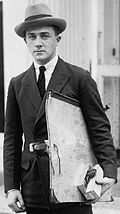 Conrad studied art in Paris with student-friend Simon Elwes (pictured here) a British war artist and society portrait painter whose patrons included kings, queens, statesmen, sportsmen, prominent social figures and many members of Britain's Royal Family.
Conrad studied art in Paris with student-friend Simon Elwes (pictured here) a British war artist and society portrait painter whose patrons included kings, queens, statesmen, sportsmen, prominent social figures and many members of Britain's Royal Family.
Upon completion of his studies, Conrad traveled to Jamaica with his father, painting and preparing for an exhibition at the Claridge Gallery in London.[36] The exhibit's paintings and drawings included Jamaican scenes, as well as portraits of H.R.H. The Duchess of Pistoia, H.S.H. The Duchess d'Arenberg, Il Duca de La Tour Corio and Il Marchese di Castlethomond.[53]
Exhibitions and Collections
Conrad has exhibited artwork in galleries and museums in Europe, Jamaica, Canada and the United States, including the following:
- The Claridge Gallery, "Conrad ffrench", London, England, Oct. 16-30, 1930[53]
- The Grand Salon, Group Exhibit, Paris, France, 1930's[36]
- Art Collection of Whyte Museum of the Canadian Rockies[54]
- Loveland Museum and Gallery, "Artistry in Living- The Life of Conrad O'Brien-ffrench", Loveland, Colorado, USA. Aug. 1- September 19, 1987.[55][56]
- Monivea Artisan Garden Gallery, Exhibit of Paintings by Conrad O'Brien-ffrench, Salt Spring Island, British Columbia, Canada. Ongoing Exhibit[57]
Teaching
Conrad taught art and held the positions of Faculty at the Banff School of Fine Arts, Banff, Alberta, 1948;[1][58][59] President of Rim Rock School of Fine Art, Loveland, Colorado, 1955;[1] and Vice President of Water Wheel Gallery, Estes Park, Colorado, 1975.[1]
Marriage and Family
On June 16, 1931 Conrad married Maud Astrid, the youngest daughter of Col. Bo Tarrass-Walhberg, of Stockholm, A.D.C. to King Gustave II of Sweden.[2][9] They were married in Paris, honeymooned in London and Austria, and then settled in Kitzbühel, Austria, where Conrad continued his work with the British Secret Service. The marriage produced a daughter, Christina Laetitia,[9] and was dissolved in 1934. Conrad remarried on May 1, 1945, in London, England, to Rosalie Isabelle Baker, daughter of Ralph George Baker.[9] They moved to Canada (see Fairholme Ranch) and had two sons, Rollo and John.[9]
Return to Secret Service
Conrad had become a personal friend of Stewart Menzies, who later (in 1939) was named head of the British Secret Service. He persuaded Conrad to rejoin the Secret Service (now as Agent Z3), and provided him with the cover of businessman.[60] The newly formed Secret Intelligence Service (SIS) network "Z" was taking shape under a variety of business covers, and Conrad established Tyrolese Tours offering package tours to Austria and Southern Germany.[65] He based himself in Kitzbühel and proceeded to establish a spy network stretching from Austria deep into Southern Germany. While in Kitzbühel, Conrad met Peter Fleming and Ian Fleming, and they often crossed paths at homes of mutual friends, at bars, on the ski slopes or at the warm-water lake, the Shwartz Zee. Conrad's style, athletic endeavors, personal adventures and experience in espionage may have provided Ian Fleming with some of his inspirations for James Bond.[61][62][63][64] He was also in attendance to Edward VIII and Wallis Simpson, who used Kitzbühel as their first home after the abdication crisis of 1936.[66]
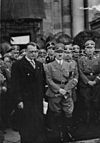 Arthur Seyss-Inquart and Hitler in Vienna, March 1938.
Arthur Seyss-Inquart and Hitler in Vienna, March 1938.
Conrad provided intelligence on Nazi occultism and the build up of German forces in preparation for World War II.[60] On Friday, March 11, 1938, Conrad received a message from an Austrian living near the Austrian/German border, reporting that German forces were advancing from Bad Toltz and Rosenheim towards the Austrian border. The timeliness of this information is critical to political and military manoeuvres. Knowing this, Conrad used the most expedient method available to transmit the message, phoning the report directly to London, even though it exposed his cover. He was told that this was the first news received from Allied capitals reporting the advance. Conrad continued to receive confirmations of the advance throughout the day. Through his local contacts he was able to warn residents, giving many in danger time to quickly pack and flee—saving lives.[60] The ease of travel quickly changed, and by the next morning Gestapo officials were ripping soles from passengers' shoes in search of money and incriminating documents. At 9 a.m., Saturday morning, March 12, a large force of German troops entered Kitzbühel, with another at Mittenwald to occupy Innsbruck and the country west as far as the Arlberg Pass.
Himmler's Gestapo, in 1940, prepared for Nazi Germany's invasion of Britain in World War II by compiling a list of more than 2,300 names of the most-wanted Britons in The Black Book (Sonderfahndungsliste G.B.).[69] It includes the name of French, Marquis de Castelchomond (sic), O'Brien with the notation "brit. Agent, Kapitan."[67][68][70] The 112th entry continues with "vermutl. England, RSHA IV E4 Stapoleit Munchen."[70] The Reich Main Security Office, RSHA, combined the SS Intelligence Service (the SD), Secret State Police (Gestapo), Criminal Police (Kripo) and Foreign Intelligence Service into an enormous organization, armed with the data and resources to commit mass murders.[71] The RSHA coding system reveals the last of the entry, with "IV E4" meaning "Counter-Intelligence in Scandinavia."[71] Conrad's cover as a spy was compromised after the Austrian Anschluss of 1938, and he retired from the intelligence services soon after.[72]During the war O'Brien-ffrench also served as Imperial censor in Trinidad.[73]
Fairholme Ranch
Conrad married Rosalie Isabelle Baker, daughter of Ralph George Baker, on May 1, 1945, in London, England. After World War II Conrad and his wife moved to British Columbia, and purchased waterfront property on Maple Bay, Vancouver Island.[74][75] Soon they moved again to "Fairholme Ranch," a property located five miles east of Banff, Alberta and within Banff National Park's boundaries.[76][77] Conrad designed and helped to build a large 14-room lodge and a cottage at Fairholme, where he and Rosie raised their sons, Rollo and John.[8][78][79] Conrad settled down to a new life of raising horses and teaching at The Banff School of Fine Arts.[74][80] Founded in 1933 by Alberta University as a school of theatrical arts, The Banff School of Fine Arts expanded its curriculum and in 1948 Conrad joined the faculty to teach visual arts.[81]
In 1958, HRH Princess Margaret, Countess of Snowdon took up residence at Fairholme Ranch during her Canadian visit of that year.[76][79][82][83][84] It provided splendid views of Princess Margaret Mountain named in honour of her visit.[85][86]
"On July 28th the Princess drove from the ranch house where she was staying, a few miles outside of Banff, to visit the Banff School of Fine Arts, where she saw students from many parts of the Commonwealth at work."[87]
The historic lodge was later carefully disassembled, moved and rebuilt just outside Stony Plain (near Edmonton, Alberta).[88]
Later years
Conrad lived in West Vancouver [75][89] and eventually retired to his chalet in Loveland, Colorado.[90] He taught and exhibited art, living out his years painting and lecturing on Art and Philosophy and Theology.[7]
Biography
O'Brien-ffrench, Conrad (1979). Delicate Mission, Autobiography of a Secret Agent. Skilton and Shaw (Fudge and Co. Ltd), London. ISBN 0-7050-0062-1.
Delicate Mission, Autobiography of a Secret Agent is in many collections, including:
- The Imperial War Museum
- The British Library
- Library and Archives of Canada
- White Museum of the Canadian Rockies
- The Alpine Club Library
Interviews
O'Brien-ffrench, Conrad (1979-10-23). Interview of Conrad O'Brien-ffrench. Interview with Dennis McCarthy. BBC Radio. Nottingham, England.
O'Brien-ffrench, Conrad (1979-10-24). Interview of Conrad O'Brien-ffrench. Interview with Bobby Vincent. London Radio. London, England.
O'Brien-ffrench, Conrad (1984-06-26). Interview of Conrad O'Brien-ffrench. Interview with Jack Savage. Cheyenne Today. KFBC. Cheyenne, Wyoming.
See also
References
- ^ a b c d e f g h i j k l m Stewart, Walter (1975), "James Bond of West Vancouver", Maclean's (February): 60–65
- ^ a b c d e f g Burke's Peerage, Baronetage and Knightage (1939). Burke Publishing Co., Ltd., London, England.
- ^ a b Obituaries: Conrad O'Briend-ffrench (1986). Loveland Daily Reporter-Herald (October 28): 10.
- ^ a b c d e f g h The National Archives: Kew, Richmond, Surrey. "Medal card of Conrad Fulke Thomond O’Brien-ffrench". http://www.nationalarchives.gov.uk/documentsonline/details-result.asp?queryType=1&resultcount=1&Edoc_Id=2372097. Retrieved 2009-10-25.
- ^ a b c d e Montgomery-Massingberd, Hugh (1976), Burke's Irish Family Records, London, UK: Burkes Peerage Ltd, pp. 411.
- ^ Massue, Melville Henry; Marquis de Ruvigny (2005). The Nobilities of Europe. Adamant Media Corporation. pp. 222. ISBN 1-4021-3111-9.
- ^ a b c d e f g h i j O'Brien-ffrench, Conrad (1979). Delicate Mission, Autobiography of a Secret Agent. Skilton and Shaw (Fudge and Co. Ltd), London. ISBN 0-7050-0062-1.
- ^ a b c d thepeerage.com. "ffrench Family: Peerage of Britain as well as the Royal Families of Europe". http://thepeerage.com/p38638.htm. Retrieved 2009-10-27.
- ^ a b c d e f g h i thepeerage.com. "Conrad Fulke Thomond ffrench: Peerage of Britain as well as the Royal Families of Europe". http://thepeerage.com/p38637.htm. Retrieved 2009-10-27.
- ^ Falls, Capt Cyril (2009). History of the First Seven Battalions: The Royal Irish Rifles in the Great War. Naval and Military Press. pp. 3–6. ISBN 978-1843422723.
- ^ The National Archives (1916). List of Officers Sent Back to Officers’ Internment Camps. Kew, London, England: The National Archives. ISBN FO 380, Copy 111 b 16478.
- ^ thePeerage.com. "Cathleen Sabine Mann= 2009-11-01". http://thepeerage.com/p2067.htm#i20665.
- ^ Dewar, Peter Beauclerk (1992). Burke's Landed Gentry of Great Britain: Together with Members of the Titles. Wilmington, Delaware: Burke's Landed Gentry of Great Britain Limited. pp. 309. ISBN 0-9711966-0-5.
- ^ O'Brien-ffrench, Conrad (1979). Delicate Mission, Autobiography of a Secret Agent. Skilton and Shaw (Fudge and Co. Ltd), London. pp. 39, 45. ISBN 0-7050-0062-1.
- ^ The National Archives (1915). Extract from letter from Lieut. Ffrench, at Burg.. Kew, London, England: The National Archives. ISBN FO 380.
- ^ Foreign Office (1915). Foreign Office Letter, May 13, 1915: Treatment of 39 British Officers in Germany. Kew, Britain: The National Archives. ISBN FO 380.
- ^ a b Andrew, Christopher M.; Oleg Gordievsky (1992). KGB: the inside story of its foreign operations from Lenin to Gorbachev. New York, New York: HarperCollinsPublishers. pp. 72. ISBN 0-0601-6605-3.
- ^ a b c Eudin, Xenia Joukoff; Harold Henry Fisher (1957). Soviet Russia and the West, 1920-1927: a documentary survey. California: Stanford. pp. 20–22. ISBN 0-8047-0478-3.
- ^ Espionage Info. "MI6 (British Secret Intelligence Service), K. Lee Lerner and Judson Knight in Encyclopedia of Espionage, Intelligence, and Security."]. http://www.espionageinfo.com/Lo-Mo/MI6-British-Secret-Intelligence-Service.html. Retrieved 2009-10-26.
- ^ Federation of American Scientists. "Secret Intelligence Service MI6". http://www.fas.org/irp/world/uk/mi6/index.html. Retrieved 2009-10-30.
- ^ O'Brien-ffrench, Conrad (1979). Delicate Mission, Autobiography of a Secret Agent. Skilton and Shaw (Fudge and Co. Ltd), London. pp. 58–65, photos. ISBN 0-7050-0062-1.
- ^ Budiansky, Stephen (2000). Battle of wits: the complete story of codebreaking in World War II. Simon & Schuster Adult Publishing Group. pp. 56. ISBN 9-7806-8485-9323.
- ^ a b Maine, Basil (1937). Edward VIII—Duke of Windsor. London: Hutchinson. pp. 266. ISBN 1-2057-304.
- ^ The Archives (1959-1992). Guide to the records in the National Archives of India, Part 3. New Delhi: The Archives. pp. 70. ISBN 1-2569-8367-4.
- ^ Mountbatten, Earl, Louis (1979). Mountbatten : Eighty Years in Pictures. New York: Viking Press. pp. 70. ISBN 1-2569-8367-4.
- ^ a b Primo Levi, Primo (2006). Gandhi. DK CHILDREN. pp. 71–75. ISBN 978-0756621117.
- ^ a b c Ravishankar Raval. "Hunting the Lion–An eyewitness record of 1922 trial of Mahatma Gandhiji". http://en.wikipedia.org/wiki/Hunting_the_Lion%E2%80%93An_eyewitness_record_of_1922_trial_of_Mahatma_Gandhiji. Retrieved 2010-10-03.
- ^ Imām, Hassan (1999). Indian National Movement. Anmol Publications. pp. 93, 134–135. ISBN 8-1261-0199-7.
- ^ Strangman, Sir Thomas (1931). Indian Courts and Characters. London: Heinemann. pp. 134–135. ISBN B001OMJ6EE.
- ^ a b c d Fischer, Louis (1982). Gandhi: His Life and Message for the World. New York: Mentor. pp. 70–72. ISBN 978-0451627421.
- ^ a b chaurichaura.com. "Chauri Chaura History". http://www.chaurichaura.com/history.php. Retrieved 2010-10-02.
- ^ Ghose, Sankar (1991). Mahatma Gandhi. South Asia Books. pp. 148–149. ISBN 8170232058.
- ^ gandhihistory.com. "Gandhi History". http://gandhihistory.com/. Retrieved 2009-10-30.
- ^ Attenborough, Richard (2008). The Words of Gandhi. Newmarket; 2 edition. pp. 80. ISBN 978-1557048073.
- ^ a b c d Sondheimer, Ernst (1989). The Alpine Journal, 1988/89: Volume 93, Number 337. The Ernest Press, London. pp. 307–309. ISBN 0-0917-3659-5.
- ^ a b c d Artistic CV, 1947
- ^ O'Brien-ffrench, Conrad (1979). Delicate Mission, Autobiography of a Secret Agent. Skilton and Shaw (Fudge and Co. Ltd), London. pp. 68–81. ISBN 0-7050-0062-1.
- ^ O'Brien-ffrench, Conrad (1978). The May Mountaineer. The Alpine Club. pp. 8–13. ISBN acl 22275.
- ^ Tattersall, E. Somerville (1933). The Alpine Club Membership Documentation, 1933. The Alpine Club, 23 Savile Row, London. pp. 1–2.
- ^ gutenberg.org. "The Project Gutenberg eBook, The Panjab, North-West Frontier Province, and Kashmir, by Sir James McCrone Douie". http://www.gutenberg.org/files/24562/24562-h/24562-h.htm. Retrieved 2011-02-05.
- ^ Summitpost.org. "Mont Collon". http://www.summitpost.org/mountain/rock/403787/mont-collon.html. Retrieved 2009-12-14.
- ^ Summitpost.org. "Dent de Perroc". http://www.summitpost.org/mountain/rock/154829/dent-de-perroc.html. Retrieved 2009-12-14.
- ^ Summitpost.org. "Sassolungo - Langkofel". http://www.summitpost.org/mountain/rock/151622/sassolungo-langkofel.html. Retrieved 2009-12-14.
- ^ Summitpost.org. "Piz Boè". http://www.summitpost.org/mountain/rock/150827/piz-bo.html. Retrieved 2009-12-14.
- ^ Summitpost.org. "Marmolada-Punta Penia". http://www.summitpost.org/mountain/rock/150474/marmolada-punta-penia.html. Retrieved 2009-12-14.
- ^ Summitpost.org. "Cima Telegrafo". http://www.summitpost.org/mountain/rock/395446/cima-telegrafo.html. Retrieved 2009-12-14.
- ^ Summitpost.org. "Monte Corona". http://www.summitpost.org/mountain/rock/494833/monte-corona.html. Retrieved 2009-12-14.
- ^ Summitpost.org. "Monte Cinto". http://www.summitpost.org/mountain/rock/152229/monte-cinto.html. Retrieved 2009-12-14.
- ^ Summitpost.org. "SCapu di u Vitullu". http://www.summitpost.org/mountain/rock/152248/capu-di-u-vitullu.html. Retrieved 2009-12-14.
- ^ Summitpost.org. "Fluchthorn". http://www.summitpost.org/mountain/rock/435247/fluchthorn.html. Retrieved 2009-12-14.
- ^ Summitpost.org. "Venediger Group". http://www.summitpost.org/area/range/151323/venediger-group.html. Retrieved 2009-12-30.
- ^ Bateson, Helen (1979), "Colorado Painter a One-Time Spy", Vancouver Express (March 14)
- ^ a b Conrad ffrench, Exhibit program, London, England: The Claridge Gallery, 16-30
- ^ White Museum of the Canadian Rockies. "Art Collection of the Whyte Museum". http://images.google.com/imgres?imgurl=http://www.whyte.org/common/images/logo.gif&imgrefurl=http://www.whyte.org/collections/collection.html&usg=__UDzPNp9VpHogJeHlIua2G8BREro=&h=61&w=132&sz=3&hl=en&start=29&sig2=Tn6lvJezsPHjuKYZ9A0IZw&tbnid=9nRoBXh3xwQgAM:&tbnh=43&tbnw=92&prev=/images%3Fq%3DConrad%2BO%2527Brien-ffrench%26ndsp%3D20%26hl%3Den%26sa%3DN%26start%3D20&ei=0jrmSqSdLZTIMeTY4Z4D. Retrieved 2009-10-25.
- ^ Walbye, Phyllis (1987), "A Life in Review: Museum Exhibits Art of O'Brien-ffrench", Daily Reporter Herald (August 1–2): 1, 3
- ^ Heath, Jennifer (1987), "Exhibit Reflects 007 Model's Life", Rocky Mountain News
- ^ Monivea Salt Spring. "About the Art / Monivea Artisan Garden Gallery". http://www.moniveasaltspring.com/www.moniveasaltspring.com/About_the_Art.html. Retrieved 2011-09-26.
- ^ "Capt. ffrench Buys Estate Near Banff", Crag & Canyon (Nov. 1), 1946
- ^ "Royal Owner of Lodge Ex-Art Instructor", Herald (July 22), 1958
- ^ a b c d McKay, C.G. (1993). From Information to Intrigue: Studies in Secret Service based on the Swedish Experience, 1939-1945. Great Britain, U.S.: Frank Cass & Co. LTD.. pp. 115. ISBN 0-7146-3470-0.
- ^ a b Scott, L. V. (2004). Understanding Intelligence in the 21st Century: Journeys in Shadows (Studies in Intelligence Series). Routledge, USA and Canada. pp. 125. ISBN 0-714-65533-3.
- ^ a b The Times Online Ben Macintyr (2008-04-05). "Was Ian Fleming the real 007? The war heroes, spymasters and beautiful women who inspired Ian Fleming to create James Bond". London. http://entertainment.timesonline.co.uk/tol/arts_and_entertainment/specials/for_your_eyes_only/article3652410.ece. Retrieved 2009-10-24.
- ^ a b West, Nigel (2005). Historical Dictionary of British Intelligence. The Scarecrow Press, Inc.. pp. 64, 161. ISBN 0810850508. http://www.amazon.com/dp/0810850508.
- ^ a b West, Nigel (2009). Historical Dictionary of Ian Fleming's World of Intelligence: Fact and Fiction. The Scarecrow Press, Inc.. pp. 40, 156–157, 218. ISBN 978-0810861909. http://www.amazon.com/dp/0810861909.
- ^ West, Nigel (2006). At Her Majesty's Secret Service: The Chiefs of Britain's Intelligence Agency, MI6. England, Canada, U.S.: Greenhill Books, Naval Institute Press. pp. 51. ISBN 1-59114-009-9.
- ^ Selby, Sir Walter (1953). Diplomatic Twilight: 1930-1940. J. Murray, London. pp. 42–43. ISBN 493743.
- ^ a b Fleming, Peter (2000), Invasion 1940, Common Reader, ISBN 1-5857-9014-1.
- ^ a b Schellenberg, Walter (2001). Invasion 1940: The Nazi Invasion Plan for Britain by SS General Walter Schellenberg. Little Brown Book Group. pp. 187. ISBN 0-9536151-3-8. http://www.amazon.com/reader/0953615138?_encoding=UTF8&ref_=sib%5Fdp%5Fpt#noop.
- ^ Deluce, Daniel (1945), "Gestapo Named British 'Criminals' 1940 List of 2,300 Suspects", Daily Telegraph
- ^ a b Schellenberg, Walter (2000). Invasion 1940. St Ermin's Press, Little Brown & Company, Imperial War Museum, London. pp. 187. ISBN 0-9536-1513-8.
- ^ a b historyplace.com. "The History Place--The Triumph of Hitler". http://www.historyplace.com/worldwar2/triumph/tr-rsha-gestapo.htm. Retrieved 2011-11-22.
- ^ Read, Anthony; David Fisher (1984). The Colonel Z: The Secret Life of a Master of Spies. Hodder and Stoughton, London. pp. 184. ISBN 0-340-026910-3.
- ^ "One-Man Art Show Original, Amusing", Vancouver Sun (May 22): 9, 1943
- ^ a b "Capt. Ffrench Buys Estate Near Banff", Crag & Canyon (Nov. 1), 1946
- ^ a b Bateson, Helen (1972), "The Real James Bond, a Retiring Figure. The Fact of the Fiction.", The Province (August 26): 28
- ^ a b Brennan, Brian (2005). Romancing the Rockies: Mountaineers, Missionaries, Marilyn, and More. Fifth House, Ltd., Calgary, Alberta. pp. 182–187, cover. ISBN 1-894856-40-6.
- ^ Lothian, W.F. (1981). A History of Canada's National Parks, Volume 3. Ottawa, Ontario: Parks Canada. pp. 100, 102. ISBN 1-380-6200.
- ^ O'Brien-ffrench, Conrad (1951), "A Ranch in the Rockies", Country Life (magazine).
- ^ a b "Official Residence", Crag & Canyon (July 23), 1958
- ^ Stewart, Walter (2000). My Cross Country Checkup. Stoddart Publishing Co., Toronto. pp. P240-246. ISBN 0-7737-3269-1.
- ^ The Banff Centre. "History of The Banff Centre". http://www.banffcentre.ca/about/history/. Retrieved 2010-09-30.
- ^ ITN Source, GAUMONT BRITISH NEWSREEL (REUTERS). "ALBERTA.....(CANADA) Princess Margaret spends 3 days during her Canadian tour & visits National Park. July 1958.". http://www.itnsource.com/shotlist//RTV/1958/08/04/BGU503050484/?s=princess+margaret. Retrieved 2009-10-24.
- ^ Willmore, Vera (1958), "Fairholme Ranch Enchants Margaret", Herald (July 8)
- ^ "Royal Visitor to Rest at Lodge Near Banff", Herald (July 19): P215, 1958
- ^ Peakfinder. "Mt. Princess Margaret". http://www.peakfinder.com/peakfinder.asp?PeakName=Princess+Margaret+Mountain. Retrieved 2009-10-24.
- ^ "Princess Margaret Mountain". Bivouac.com. http://www.bivouac.com/MtnPg.asp?MtnId=16889. Retrieved 2009-10-24.
- ^ "The Princess and the Ballet Dancers: A Delightful Scene During Princess Margaret's Visit to the Banff School of Fine Arts on the Third Day of Her Stay in Alberta", The Illustrated London News (August 9), 1958
- ^ Gravelines, Gail (1982), "History in the Remaking", Edmonton Journal (Nov. 18)
- ^ Bateson, Helen (1970), "Master Spy Lives in Quiet Retirement Here", Lions Gate Times (8)
- ^ Ennsslin, John C. (1985), "Ex-British Spy Becomes Ordinary Person", Rocky Mountain News (January 2): 14
External links
- Artwork of Conrad O'Brien-ffrench at Monivea Artisan Garden Gallery [1]
- Ffrench Family Association: ffrenches of Monivea Castle [2]
- Conrad Faulk O'Brien-ffrench. Artist and Spy [3]
- Conrad O'Brien-ffrench on FaceBook [4]
- Follow on Twitter @OBrienffrench
- History of the Banff Centre (The Banff School of Fine Arts) [5]
Categories:- 1893 births
- 1986 deaths
- World War I spies for the United Kingdom
- Royal Irish Regiment (1684-1922) officers
- British Army personnel of World War I
- Royal Canadian Mounted Police officers
- World War I prisoners of war
- People from London
- MI6 personnel
- British prisoners of war
Wikimedia Foundation. 2010.

